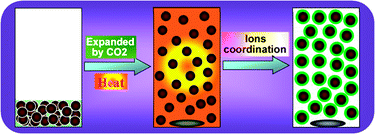A new strategy for finely controlling the metal (oxide) coating on colloidal particles with tunable catalytic properties†
Abstract
In this contribution, we present an efficient, versatile and green strategy for finely controlling the metal (

* Corresponding authors
a State Key Laboratory of Electroanalytical Chemistry, Changchun Institute of Applied Chemistry, Chinese Academy of Sciences, Changchun, P. R. China
b
Laboratory of Green Chemistry and Process, Changchun Institute of Applied Chemistry, Chinese Academy of Sciences, Changchun, P. R. China
E-mail:
zhaofy@ciac.jl.cn
Fax: +86-431-85262410
Tel: +86-431-85262410
c University of the Chinese Academy of Sciences, Beijing, P. R. China
In this contribution, we present an efficient, versatile and green strategy for finely controlling the metal (

 Please wait while we load your content...
Something went wrong. Try again?
Please wait while we load your content...
Something went wrong. Try again?
J. Ming, H. Cheng, Y. Yu, Y. Wu and F. Zhao, J. Mater. Chem., 2011, 21, 6654 DOI: 10.1039/C0JM04456C
To request permission to reproduce material from this article, please go to the Copyright Clearance Center request page.
If you are an author contributing to an RSC publication, you do not need to request permission provided correct acknowledgement is given.
If you are the author of this article, you do not need to request permission to reproduce figures and diagrams provided correct acknowledgement is given. If you want to reproduce the whole article in a third-party publication (excluding your thesis/dissertation for which permission is not required) please go to the Copyright Clearance Center request page.
Read more about how to correctly acknowledge RSC content.
 Fetching data from CrossRef.
Fetching data from CrossRef.
This may take some time to load.
Loading related content
